We are particularly interested in this area as our home is here. The following account has been compiled from various available sources, so we should be very pleased to hear from you if you have further information that could be added to the story.
Ford Farm & Ford Mill is located on the Northern Boundary of Whitwell, along the Eastern Yar stream that runs through the farm. The farm is located at the top of Ford Farm Lane which is off of Newport Road, Niton.
Joanne Thornton (no relation to us) says in her book, “Whitwell, history of a village”, written in 2011:
”Ford Mill is no longer in use. It was a corn mill and was once owned by St. Helen’s Priory. It dates back to at least 1558.”
A Priory at St Helens, Isle of Wight, was founded after the Norman Conquest by French Benedictine monks. The Benedictine community in St Helens survived for over 300 years until financial problems led to it disbanding in 1414. www.nationaltrust.org.uk/st-helens-duver/features/the-story-of-st-helens-old-church.
“The origins of St Helens derive from the Cluniac Priory, built circa 1080, the remains of which are now the site of the Priory Bay Hotel just outside the village.” www.sthelensiw.org.uk/about-us/
The earliest reference to Ford Farm that we have found is in 1560 when a Richard Newman was stated to be “of Northford”. Southford Mill lies about 300 yards to the south. The Worsley family, the Island’s greatest landowners for three hundred years until 1809, were subsequently in possession, with Edward Worsley mentioned in 1712 as being “of Ford”.
A little distance away from the house which was originally known as “Granville” and is now “Ford Farm House”, is the location of the old Ford Mill, which, sadly, no longer exists, and also the original farmhouse, now known as Ford Manor, with parts of that dwelling dating to 1618.
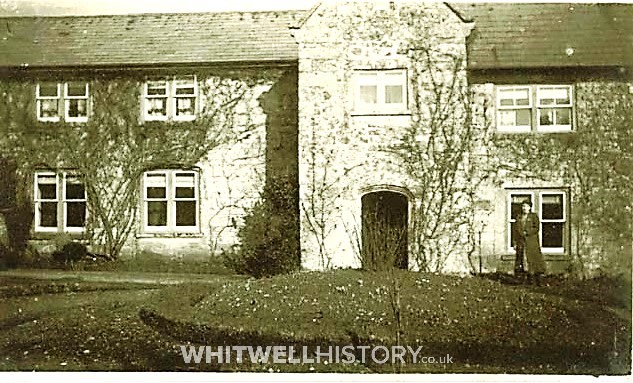
Original Farmhouse: woman unknown, date uncertain, possibly 1940’s/50’s.
Interesting references to the history of Ford Farm & Ford Mill through the centuries have been found:-
The Rivers Report of 2012, (www.islandrivers.org.uk) describing the Eastern Yar.
Catchment area – Upper Yar sub-catchment – and in the section about the Eastern Yar valley west of Godshill states that:
“There are a number of water mills mentioned in a 16th (century) document in this area (Southford Mill, Ford Mill and Bridgecourt Mill). All are shown on the 1793 OS map.”
” A document of 1712 (JER/SEL/89A/1 at the IW Record Office) states “Edward Worsley, late of Gatcombe, now of Ford, quarter of Whitwell, p. Gatcombe.”
In 1737 “Ford Farm in the parish of Whitwell” is included In a Marriage Settlement between Edward Worsley of Gatcombe and Elizabeth Miller of Chichester.
“Robert Buckell married Mary Kemp in 1785 at Godshill, and their son, Francis, was born about 1791. He married Mary Way in 1818 and died in 1839, and they lived at Ford Farm.” – Roger Duffet (
This record is held by Isle of Wight Record Office
| Reference: | JER/WA/31/73 |
| Title: | Lease for 99 years on 2 lives of messuage and tenement called HORNGATE, 3a., p. Whitwell, I.W. |
| Description: | (1) Sir Richard Worsley of Appuldurcombe, I.W.
(2) Hannah Reynolds, widow, of Ford Mill, p. Whitwell
Term to commence from expiration of lease dated 1768 August 11, Sir Thomas Worsley to Thomas Jones, now deceased. Consid: £60 5s. p.a. |
| Date: 1804 June 21 |
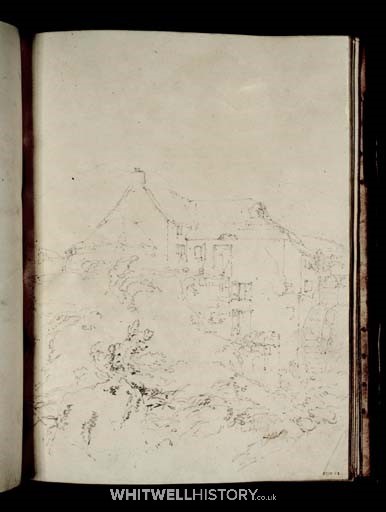
A Watermill 1795 – Joseph Mallord William Turner
Joseph Mallord William Turner 1775–1851
Folio 34 Recto:
A Watermill 1795
D00441
Turner Bequest XXIV 33
Pencil on white wove paper, 264 x 204 mm
Stamped in black ‘XXIV 33’ bottom right
Accepted by the nation as part of the Turner Bequest 1856
References
Dearden suggests that this shows Ford Mill, Whitwell, Isle of Wight. Whitwell is a small village inland from St Lawrence, outside Ventnor (see folio 30 recto; D00437; Turner Bequest XXIV 29); the mill is not extant.
Verso:
Blank; stamped in brown ink with Turner Bequest monogram.
Andrew Wilton
April 2012
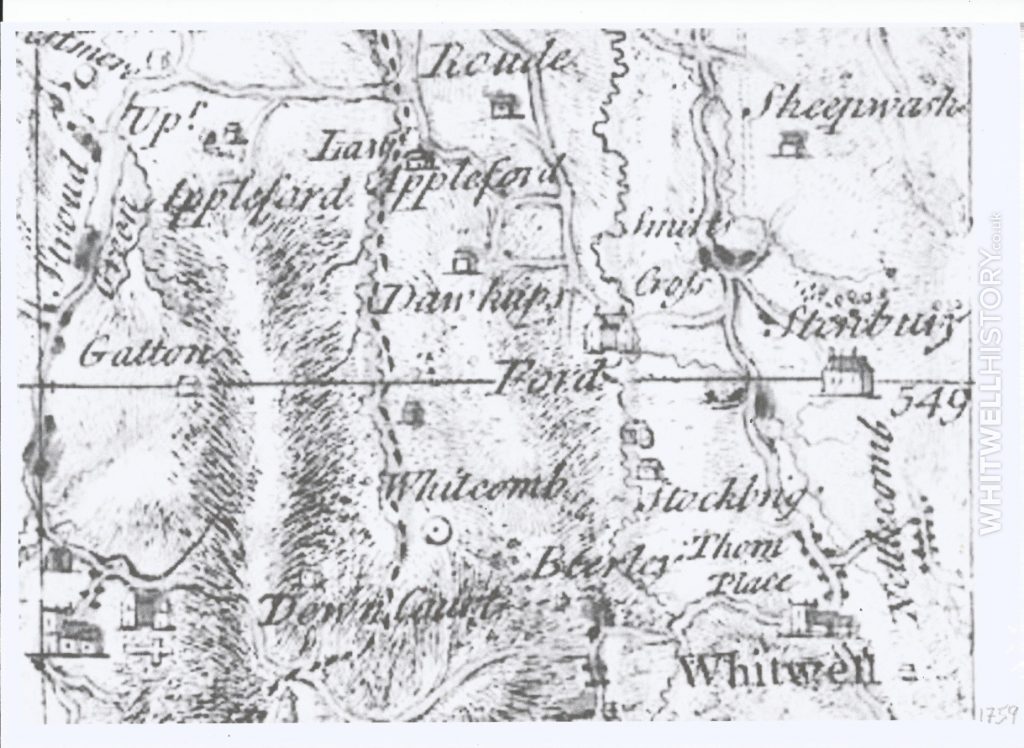
Map 1759
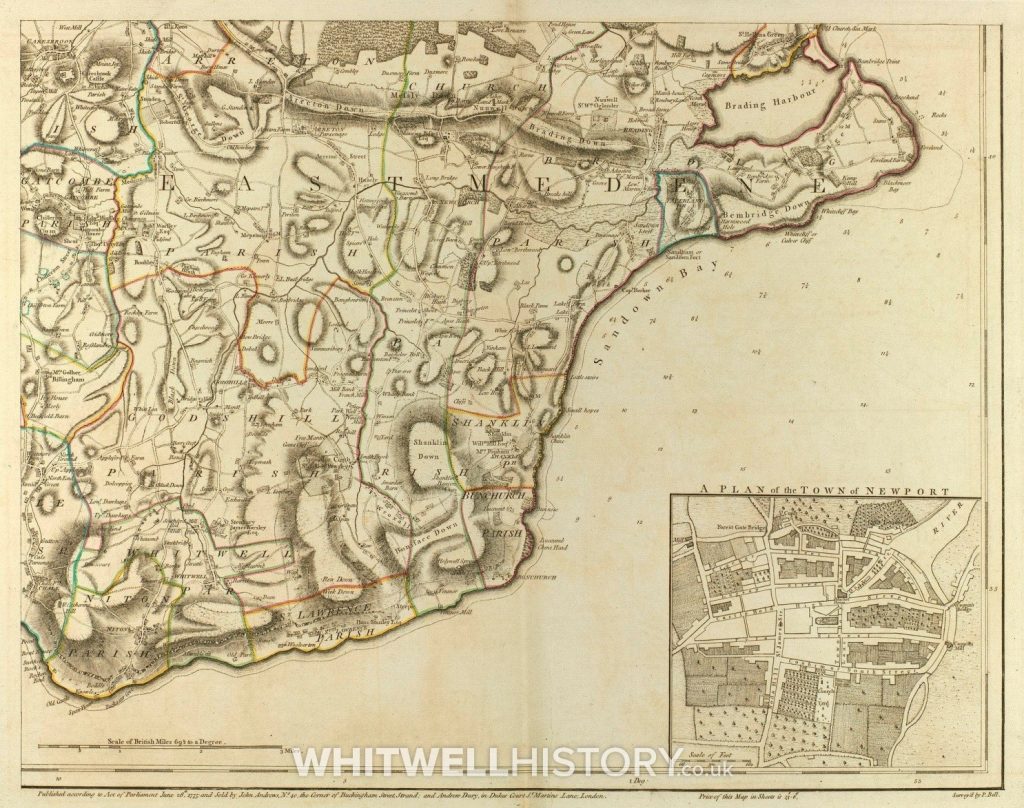
John Andrew’s Map 1775
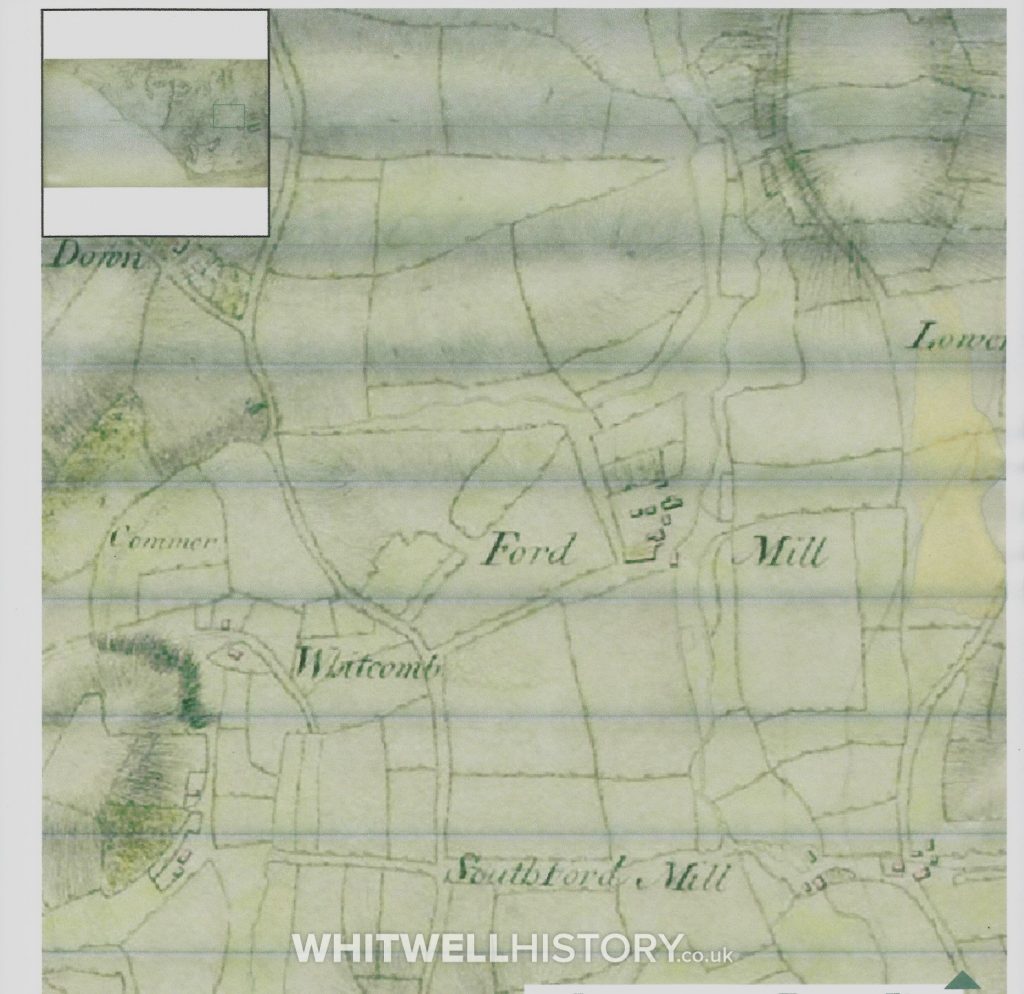
William Gardner’s Map of 1793
The 1841 census lists Mary Buckell at Ford, with Francis, her son, aged about 20, a farmer, and five more children, all daughters. At Ford Mill are William Reynolds, Miller, 45, and wife, Mary, 55. Francis (1819-1873), who married Emma Galt in 1847, had a son, also Francis, born in 1849, and this is confirmed by the 1851 census entry for Ford Farm where we find Francis, 31, a Farmer with 300 acres, with his wife Emma and 1yr old son, Francis Galt Buckell. Also listed with them are two house servants and five farm labourers. At Ford Mill is Matthias Roberts, 22 years old; although his occupation is “Miller”, he is also described as “Servant”. This would indicate that Francis was the owner of the mill at that time.
In 1857, Francis Buckell, Ford, Whitwell, is listed in the UK Poll Books.
Ten years later, in 1861, Francis and Emma are still at Ford House, a farmer with 250 acres. Edward, Francis’ brother, a gentleman, is staying with them and there are two servants. Their son, Francis Galt Buckell, is found at Richmond House School, in Reading, so this might point to the fact that the farm was doing very well and Francis had become prosperous enough to be able to send his son away to school. There are two entries for Southford Mill, which seems to be an error, and the first of these is most likely to be Ford Mill. Charles Chiverton, 25, is the Miller, with his wife, Fanny, 24, and son, James 15(!) – Another mistake? Was he Charles’ brother?
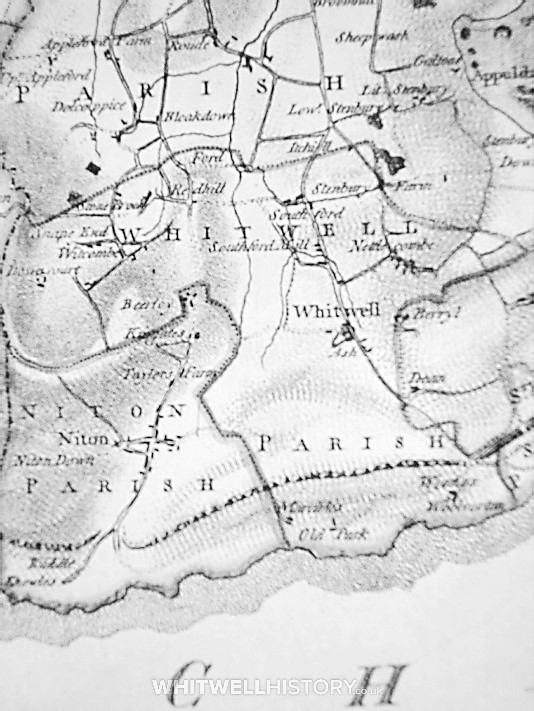
Worsley’s Map of Whitwell 1781
By the time of the census of 1871 much had changed at Ford, and a surprising event had taken place. The travel and immigration records that are to be found on “Find My Past” show that Francis and Emma, and 18yr old son, Francis, is listed on “Victoria (Australia) Inward Passenger Lists” for 1868.
What caused them to make the brave decision to up sticks and leave the peace and quiet of a small island where they had lived all their lives to travel so far to an unknown country is difficult to understand. However, they all lived and died there as can be seen by this headstone which is in the White Hills Cemetery, Bendigo, Victoria, Australia. Francis was there only a few years before he died in 1873; Emma, twenty years later in 1893, and son Francis, who married an Australian and had one son, in 1930.
“Sacred to the memory of Francis Buckell late of Ford, I.O.W………..Emma……”
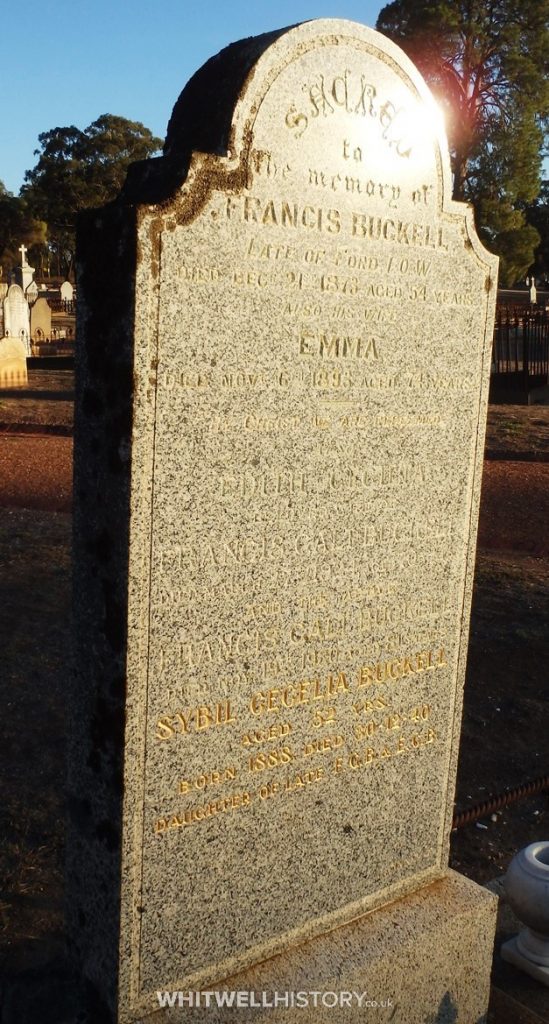
Francis Buckell of Ford Grave Stone
(Plot Mon C3 Grave Number 6988 Memorial ID 159158724)
www.search.findmypast.co.uk/results/world-records-in-travel-and-migration
www.migrationheritage.nsw.gov.au
So, by 1871, Frank Attrill had taken over the rental of the farm of 287 acres and lived at Ford Farm House, the original dwelling that is now called Ford Manor, with Elizabeth Jane, his wife, and his sons, Francis (!) and Robert, and two domestic servants. At Ford Mill House, are James Eldridge, his wife Elizabeth, and four children. His occupation is given as Agricultural Labourer, and there is no mention of a miller. Interestingly, there is an entry: – Southford, Old Mill House, with an Agricultural labourer and his family also living there. Does this mean that the mills had become uneconomical to run and were no longer in use?
5th Dec 1867 was the date that Frank Payne Attrill and Elizabeth Jane Attrill were married. However, their marriage was very short, barely four years, as Frank died suddenly on 26th October 1871, and Elizabeth was a widow at only 26 years of age. Even so, she continued to run the farm of 260 acres, although by 1881she was helped by a Farm Manager, her uncle, Leonard Attrill. Previously, he was a farmer at Corve Farm in Chale with 192 acres and had married Matilda Sparks in 1868. Sadly, she died five years later, in 1873, so that Elizabeth and Leonard shared a similar loss and a common interest in farming.
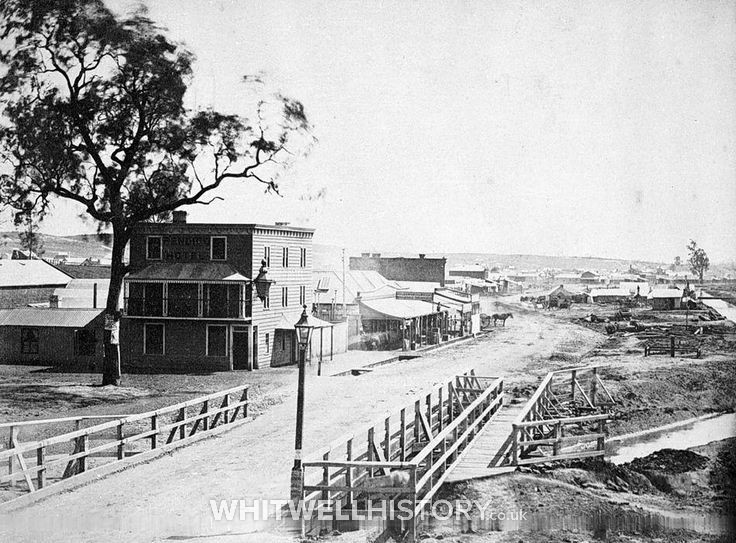
Bendigo in 1854
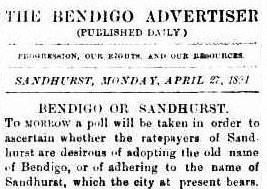
The Bendigo Advertiser 1891
https://blogs.slv.vic.gov.au/such-was-life/bendigo-or-sandhurst-history-through-newspapers/

1 of 2 Reports from the Hampshire Advertiser, 31 March 1855
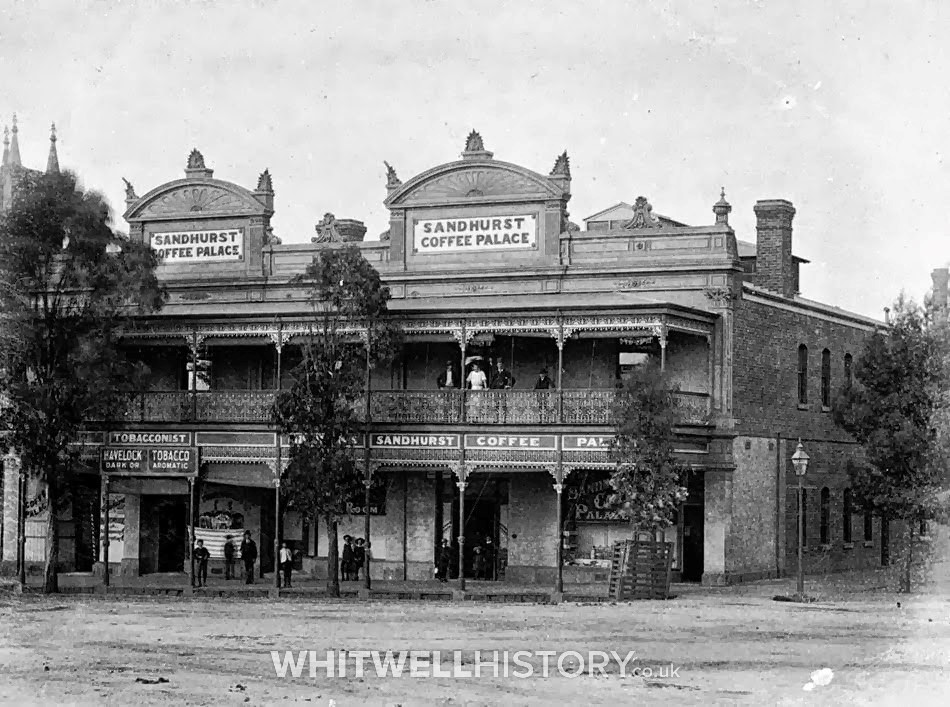
Sandhurst Coffee Palace
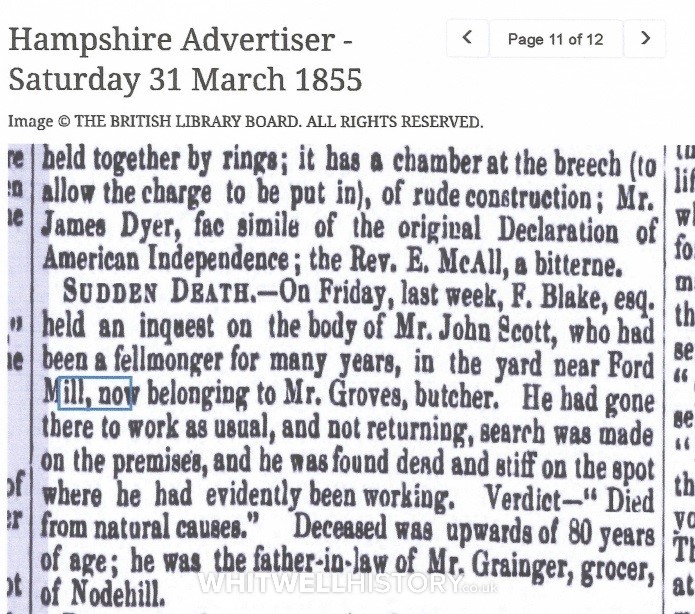
2 of 2 Reports from the Hampshire Advertiser, 31 March 1855
It seems that the business of running the mills, Ford and Southford, was fraught with financial pitfalls as the following reports will show.
In 1881, Ford Mill was in use again, with Alfred Trim, 37, a Master Miller, employing one man and two boys. Living there with him was his wife, Georgina, and eight children. The census shows that Southford Mill was also in operation at that time, but in July 1882, it was reported that “A. Trim of Ford Mill & Southford Mill” had been declared bankrupt.
Another newspaper report dated 9th January 1886 informs us that:
“Walter Mansbridge “the debtor, came up for his public examination…..he took Ford Mill in 1882 with a loan of £50 and his turnover in the first year was about £1400. He took Southford Mill in 1884. He left the mills about the beginning of July because he got behind a good deal.”
Ten years later, and the Miller at Ford is Wallace Lock, 28, unmarried, but he has his sister, Annie, living with him. Elizabeth Attrill is at Ford Farm, a farmer, with her son, Francis William, and Leonard.
However, in about 1896, a Frederick Reynolds Hourd from Nottinghamshire became the miller for both Ford Mill and Southford Mill. Again, something went wrong, and in 1899 he was declared bankrupt. (www.thegazette.co.uk/) He subsequently went to live in Lincolnshire, and by 1901, Francis William Attrill, now 32, is the Miller and married to Rowena, with a two-year-old son, Frank, and a baby daughter, Marie.
In 1911, Elizabeth and Leonard are still farmers, and still at Ford Farm. However, Francis William, Rowena and their three children are now living at Granville and he is an Assistant Farm Manager. There is no mention of the Mill in this census, so should we assume that modern progress with mechanisation and transport brought about the end of its useful life.
Granville, known today as Ford Farm House, must have been built, we think, around 1900 (it was extended in 1988), presumably as a comfortable, new home for Francis and his family. The house was probably given its name because it was built by the then landowner, Edmund Granville Ward.
Mention should be made of Elizabeth & Frank’s other son, Robert Leonard Attrill who was born in 1870. He married Bertha Louise Maule in 1890 and then in 1903 we find him sailing on the SS Inyati to Port Natal; with him are his wife and four children, with ages from eight to one year, He must have settled there, as the next record that has been found is dated December 11th 1931, when he is again travelling to Natal, now part of South Africa, from London, this time on the Warwick Castle. He is alone; his last address in the UK is given as “Ford Farm, Whitwell” and his occupation as “Butcher”.
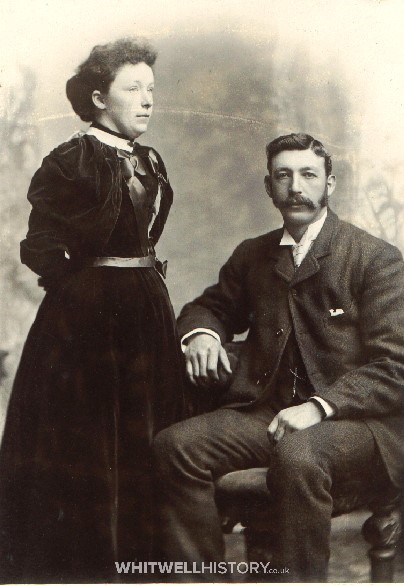
Francis William Attrill with wife Rowenda Colenutt
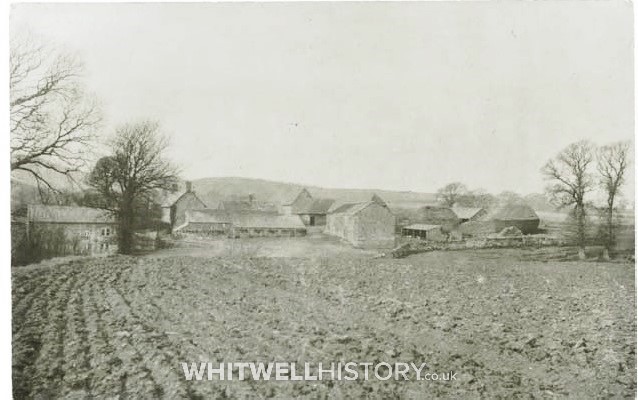
Photograph of Ford, taken from the east, possibly 1940/50’s. The Mill House shows clearly on the left.
Elizabeth died in 1928 and Leonard in 1939.
So what is the next stage of Ford’s five hundred year history?
There is a map of 1920, produced by the Auctioneers, Sir Francis Pittis & Son – “The Third Portion of the Ward Estate, Isle of Wight” – identifying six different lots of land in Whitwell “for Sale by Auction”. Lot 1 includes Ford Farm and about twelve surrounding fields. Interestingly, Granville is shown separately as Lot 2. An account of the Auction in the I.W.County Press for 22nd May 1920 relates that many of the properties and land from different areas of the Island were sold off individually, and many to the existing tenants of the property. At the end of the account is: –
“The valuable agricultural estate, Ford Farm, Whitwell, consisting of 295 acres, a good farmhouse, and another modern residence, Granville, 10 cottages, stabling for 14 horses and 29 cows, seven piggeries, and numerous other buildings, let for many years to Mrs. E.J.Attrill, at a rent of £382.16s, was the last lot of the estate offered. Bidding commenced at £8000 and rapidly advanced to £12,500, but the property was not sold in the room.”
A subsequent entry in the County Press, on 25th September 1920, lists for sale by Private Treaty several properties that were not sold at the auction. Among them are Ford Farm and Granville, but there is a note at the end of the list to the effect that they had now already been sold.
But, who had bought them? No definite information has been found regarding the Farm, but Elizabeth’s brother, William Henry Attrill, must have purchased Granville from the Ward Estate as the entry in the National Probate Calendar states that William, of Granville, died at Ford Farm, 31st December 1930, and that Probate was granted to Francis William Attrill, Elizabeth’s son. The information contained in a later Conveyance document of the property confirms this.
We are fortunate that it is now possible, through the “Find My Past” website, to view the 1939 Register.* and from this important record, we learn that Frank Ronald Attrill, son of Francis, and grandson of Elizabeth, was living at Granville, with his wife, Gertrude. His occupation was given as Shepherd, Tractor Driver. There were also two daughters, and Gertrude’s widowed mother, Gertrude Brown. Ford Mill is listed but is unoccupied. At Ford Farm, we find Edward Brown, Gertrude’s brother, along with his wife Marie, and children, Harold and Elizabeth. Also there, are Francis William Attrill and Rowena, both described as incapacitated – a total of eleven family members altogether. Francis died quite soon after the Survey was taken, on the 8th October 1939, and Granville was passed on to Frank Ronald.
The Conveyance document referred to above is for the sale of Granville and is dated 12th January 1943. In it, we see that Frank Ronald Attrill sold Granville to Reginald Maurice Flux, of Scotland Farm, Godshill, his brother-in-law at the time, for the sum of seven hundred pounds. He also purchased the Farm, and, by 1957 Reginald’s son, James (Jimmy) was living at Granville with his wife, Anne, and two children, and the farmhouse (now known as Ford Manor) was either sold or let.
Reginald had married Laura Mullet in 1920, and their son, James Thomas, was born in 1925. Laura died in 1927 and, in 1931, Reginald married Lilian Eugenie Attrill, daughter of Francis and Rowena.
*This information is taken from the National Archives website – www.nationalarchives.gov.uk/help-with-your-research/research-guides/1939-register/
The 1939 Register, taken on 29 September 1939, provides a snapshot of the civilian population of England and Wales just after the outbreak of the Second World War. Details of around 40 million people were recorded in more than 65,000 volumes (transcript books), now held in record series RG 101.
The 1939 Register is a digital-only record: the original register books have been retained by the Health and Social Care Information Centre, now named NHS Digital, and are not held at The National Archives.
The information was to produce Identity Cards and, once rationing was introduced in January 1940, to facilitate the issuing of ration books. Information in the Register was also used to administer conscription and division of labour, and to monitor and control the movement of the population caused by military mobilisation and mass evacuation.
The 1939 Register is a useful resource for family, social and local historians. As the 1931 census for England and Wales was destroyed by fire during the Second World War and no census was taken in 1941, the 1939 Register provides the most complete survey of the population of England and Wales between 1921 and 1951.
While the 1939 Register is not a census, it is arranged along similar lines and includes similar, if less detailed, information. It does, however, show exact dates of birth, while census returns simply give a person’s age.
It seems that during the next thirty years there were various occupiers of the farm, and of Granville, who had either purchased all or part of the whole farm property or rented it from the current owners. Eventually, it was all sold and Granville had been extended in 1989 to make a larger house, subsequently being known as Ford Farm House. By 1990 Mr & Mrs Piper were the owners, farming many acres of land. The old farmhouse, the Manor, was sold in about 1996, and also, gradually, were various fields and barns, until by 2008 the ownership of all the farm buildings, barns and some land, was divided amongst four families, with some of the barns being converted to new homes or holiday accommodation.
There is a reference to Ford Mill in J. Kenneth Major’s book “The Mills of the Isle of Wight” written in 1970, in which he says:
“To the east of the ancient Ford farmhouse the land falls away steeply to the eastern River Yar at the bottom of its valley.
“On the side of this slope the mill dam and contour mill stream have been created.
“The mill pond is, therefore, long and narrows, stretching back almost to Southford mill…
“At the end of the mill dam are high ruined walls which were part of the mill…The wheel pit is still visible…..A length of the upright shaft remains…This mill was last recorded as trading in Kelly’s Directory for the year 1911.”
The Mill House became derelict and now has disappeared completely.
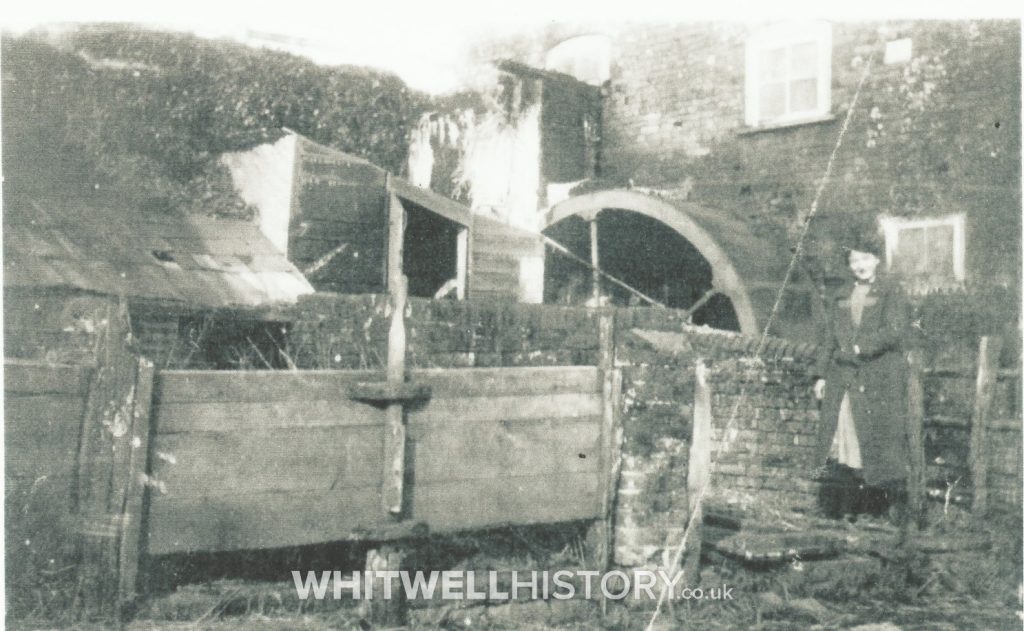
The Mill and the Mystery Woman
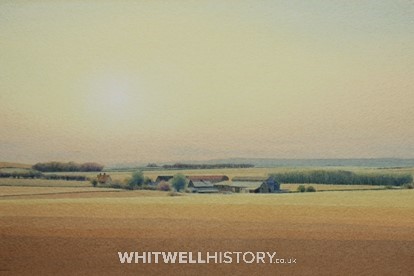
A Modern Painting of Ford Farm
Bears the following handwritten inscriptions on the backboard:
MARTIN SWAN / 1 CROSS FARM COTTAGE / MANOR RD / WROXALL TEL: 884922
TITLE: FORD FARM, WHITWELL
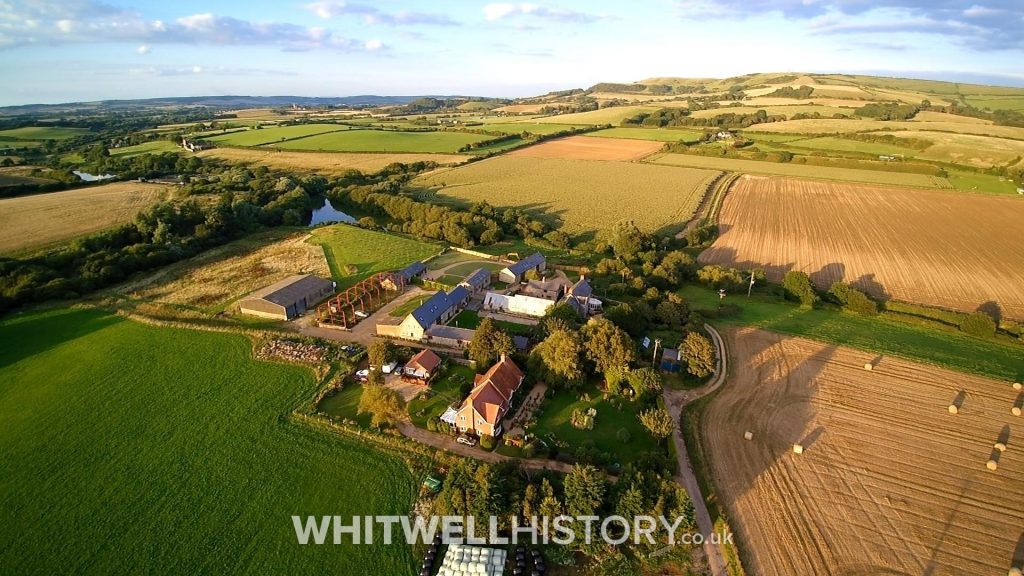
Ford Farm in 2017
BIBLIOGRAPHY, REFERENCES AND WEBSITES
“The Mills of the Isle of Wight” J. Kenneth Major B.ARCH., A.R.I.B.A. 1970 published by Charles Skilton Ltd.
“Whitwell, history of a village” Joanne Thornton 2007 ISBN: 978-1-4092-5852-0
Isle of Wight County Press and South of England Reporter Archives
Roger Duffet (descendant of the Buckell family)
Other photographs courtesy of Joanne Thornton (no relation), and descendants of the families mentioned.
All information correct to the best of our knowledge at the time of publishing in August 2019.
Information compiled by Shirley Thornton.
You can find out more about the history of Whitwell by visiting the ‘Village History‘ page.